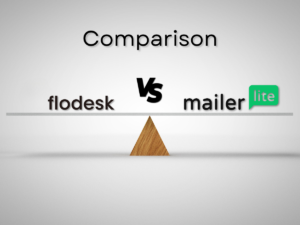Campaign Monitor vs TinyEmail
Introduction
In today’s fast-paced digital era, the power of email marketing cannot be overstated. It remains a cornerstone in the arsenal of digital marketing strategies, offering unparalleled reach and engagement with audiences across industries. With this in mind, selecting the right email marketing tool becomes a critical decision for businesses aiming to unlock the full potential of their marketing campaigns. This brings us to an in-depth comparison of two notable contenders in the email marketing domain: Campaign Monitor and TinyEmail.
Table of Contents
Our guide is tailored to navigate you through the key features, benefits, and considerations of Campaign Monitor vs TinyEmail, helping you discern which platform aligns best with your marketing objectives. Whether you’re a seasoned marketer looking to refine your strategy or a small business owner stepping into the realm of email marketing, understanding the nuances of these platforms is pivotal.
The comparison between Campaign Monitor vs TinyEmail will be thorough and encompass various dimensions of email marketing tools, from usability and design flexibility to automation capabilities and analytical insights. Our aim is to present an informative, concise, and easily digestible breakdown that will empower you to make an informed choice that catalyzes your marketing success.
Ease of Use

Navigating the realm of email marketing platforms can be a daunting task, especially when the ease of use is a top priority for ensuring seamless campaign management. In the comparison of Campaign Monitor vs TinyEmail, understanding how each platform facilitates a user-friendly experience is crucial for marketers at all levels. Both platforms strive to offer intuitive interfaces and simplified processes, but they do so with unique approaches that cater to different user preferences.
Campaign Monitor and TinyEmail both feature drag-and-drop email builders, which are central to their appeal for users seeking simplicity without sacrificing design quality. This functionality allows for quick creation of visually appealing emails, with minimal learning curve involved. However, the overall user experience extends beyond just email creation; it encompasses the setup process, navigation through the platform, and the ease of accessing various features.
One area where users might notice differences is in the initial setup and onboarding process. Campaign Monitor offers a straightforward onboarding experience, with guided tutorials and resources readily available to help new users familiarize themselves with the platform. TinyEmail, while also emphasizing a user-friendly setup, leverages AI-driven tools to potentially streamline the process even further, suggesting optimizations and improvements as you build your first campaign.
Template Design and Customization
Diving deeper into our comparison of Campaign Monitor vs TinyEmail, the design and customization of email templates emerge as pivotal factors that can greatly influence the effectiveness and visual appeal of your email campaigns. Both platforms offer a range of templates and customization options, but they cater to these needs in ways that reflect their unique understanding of user preferences and design innovation.
Campaign Monitor and TinyEmail provide users with a rich library of email templates designed to meet various marketing needs, from newsletters and announcements to promotions and event invitations. These templates are crafted not only with aesthetics in mind but also with a focus on responsiveness, ensuring your emails look great on devices of all sizes—a critical consideration in today’s mobile-first world.
Customization is where the platforms really showcase their capabilities. Campaign Monitor offers a highly intuitive drag-and-drop editor, allowing users to modify templates with ease. You can add your brand colors, logos, and other elements without needing to code, making it straightforward to create personalized emails that resonate with your brand identity. TinyEmail, on the other hand, leverages AI-driven technology to suggest design improvements and customization options. This not only simplifies the customization process but also helps optimize your emails for higher engagement rates based on data-driven insights.
Email Automation Features

As we delve deeper into the comparison between Campaign Monitor vs TinyEmail, it becomes evident that the power of email marketing is significantly amplified through advanced automation features. Automation not only streamlines the workflow but also ensures that your messages reach the right people at the right time, based on predefined triggers and behaviors. Understanding how each platform leverages automation will reveal which is best suited to your marketing strategy’s complexity and sophistication.
Campaign Monitor’s Precision and Ease
Campaign Monitor is celebrated for its user-friendly automation tools that allow marketers to set up complex email sequences with ease. Its platform enables the creation of targeted workflows designed to engage subscribers based on specific actions, such as opening an email or visiting a webpage. Campaign Monitor’s strength lies in its intuitive interface, which simplifies the process of designing automation sequences, making sophisticated marketing strategies accessible to all users, regardless of their technical expertise.
TinyEmail’s AI-Driven Insights
As we delve deeper into the comparison between Campaign Monitor vs TinyEmail, it becomes evident that the power of email marketing is significantly amplified through advanced automation features. Automation not only streamlines the workflow but also ensures that your messages reach the right people at the right time, based on predefined triggers and behaviors. Understanding how each platform leverages automation will reveal which is best suited to your marketing strategy’s complexity and sophistication.
Campaign Monitor’s Precision and Ease
Campaign Monitor is celebrated for its user-friendly automation tools that allow marketers to set up complex email sequences with ease. Its platform enables the creation of targeted workflows designed to engage subscribers based on specific actions, such as opening an email or visiting a webpage. Campaign Monitor’s strength lies in its intuitive interface, which simplifies the process of designing automation sequences, making sophisticated marketing strategies accessible to all users, regardless of their technical expertise.
TinyEmail’s AI-Driven Insights
TinyEmail takes a slightly different approach by incorporating AI technology to enhance its automation features. This AI integration aids in the analysis of subscriber behaviors, enabling the platform to automatically adjust the timing and content of emails to maximize engagement. TinyEmail’s focus on AI-driven personalization and optimization means that campaigns can become more effective over time, as the system learns from user interactions and refines its strategies accordingly.
List Management and Segmentation
Progressing in our comparative analysis of Campaign Monitor vs TinyEmail, we pivot to a critical aspect of email marketing effectiveness: list management and segmentation. The ability to organize and segment your audience based on specific criteria is not just a feature but a necessity for targeted, personalized marketing campaigns. Both Campaign Monitor and TinyEmail offer tools for this, but they do so with distinct functionalities and user experiences.
Tailored Audiences with Campaign Monitor
Campaign Monitor excels in providing marketers with sophisticated list management tools that enable precise segmentation. Users can segment their lists based on a variety of criteria, including demographics, subscriber behavior, and engagement levels. This allows for highly targeted email campaigns that resonate with different segments of your audience, thereby increasing relevance and engagement. Campaign Monitor’s interface makes it straightforward to create and manage these segments, ensuring marketers can easily tailor their strategies to diverse audience needs.
Dynamic Segmentation in TinyEmail
TinyEmail approaches list management and segmentation with a dynamic edge, leveraging AI to analyze subscriber interactions and automatically create segments. This AI-driven approach not only saves time but also uncovers patterns and segments you might not have considered, leading to more effective and personalized campaigns. TinyEmail’s platform simplifies the segmentation process, allowing for real-time adjustments and optimizations based on evolving subscriber behavior and preferences.
Deliverability Rates
In our ongoing comparison of Campaign Monitor vs TinyEmail, the topic of deliverability rates takes center stage. The ability of an email marketing platform to successfully land emails in subscribers’ inboxes, avoiding spam filters and other barriers, is a cornerstone of effective email marketing. Both Campaign Monitor and TinyEmail recognize this and have implemented measures to maximize deliverability rates for their users.
Campaign Monitor’s Proactive Approach
Campaign Monitor prides itself on its robust infrastructure and best practices designed to ensure high deliverability rates. The platform offers comprehensive guides and tools to help users craft emails that comply with anti-spam laws and best practices, significantly increasing the chances of emails reaching their intended destination. Furthermore, Campaign Monitor maintains strong relationships with major ISPs and email providers, ensuring their senders’ reputations are preserved and emails are less likely to be marked as spam.
TinyEmail’s Innovative Edge
TinyEmail, while also focusing on high deliverability rates, leverages AI technology to optimize email send times and content for improved inbox placement. Its system analyzes user engagement to determine the best times to send emails, thereby increasing open rates and minimizing the risk of emails being overlooked or marked as spam. TinyEmail also continuously monitors email campaign performance, offering insights and suggestions for improvement based on real-time data.
Analytics and Reporting

Continuing our exploration into the features of Campaign Monitor vs TinyEmail, the aspect of analytics and reporting emerges as a vital tool for measuring the success and efficiency of email marketing campaigns. The capacity to track, analyze, and act on email campaign data not only informs strategic decisions but also drives continuous improvement in engagement and conversion rates. Let’s delve into how each platform equips users with the analytics and reporting capabilities necessary for data-driven marketing.
In-Depth Insights with Campaign Monitor
Campaign Monitor provides comprehensive analytics and reporting features that give users a detailed overview of their email campaign performance. The platform offers metrics on opens, clicks, bounces, and conversions, allowing marketers to gauge the effectiveness of their campaigns at a glance. Additionally, Campaign Monitor includes advanced features like A/B testing results and social sharing statistics, enabling users to refine their strategies based on actionable insights. The interface is designed for accessibility, presenting data in a clear, visual format that simplifies analysis and reporting.
Real-Time Analytics in TinyEmail
TinyEmail takes a dynamic approach to analytics, offering real-time reporting that allows marketers to monitor campaign performance as it happens. This immediacy is crucial for making on-the-fly adjustments to maximize campaign effectiveness. TinyEmail’s analytics go beyond basic metrics, incorporating AI to provide predictive insights and recommendations for future campaigns. This forward-looking analysis helps users anticipate trends and adjust their strategies accordingly, ensuring that their email marketing efforts are always one step ahead.
Integration Capabilities
Exploring the realm of integration capabilities within our ongoing comparison of Campaign Monitor vs TinyEmail reveals the significance of seamless tool and service connections in enhancing and streamlining email marketing efforts. Integrations extend the functionality of an email marketing platform, allowing for a more efficient workflow, better data synchronization, and enriched subscriber experiences through personalized content. Both Campaign Monitor and TinyEmail understand the importance of these integrations, albeit with differing approaches that cater to diverse marketing needs.
Campaign Monitor has established itself with an expansive ecosystem, offering a wide variety of integrations across several categories, including CRM systems, social media platforms, eCommerce solutions, and more. This broad range ensures that marketers can easily connect their email campaigns with other aspects of their digital strategy, creating a cohesive and unified marketing effort. The availability of diverse integrations means that whether you’re looking to automate the import of subscriber lists, dynamically update customer information, or trigger emails based on specific actions, Campaign Monitor likely has the tools to support your needs.
On the flip side, TinyEmail, while perhaps not offering as extensive a range as Campaign Monitor, focuses on delivering a curated selection of high-value integrations. This approach aims to provide users with streamlined and effective connections to key services, emphasizing quality and depth of integration over sheer quantity. By concentrating on integrating tightly with essential CRM platforms, analytics tools, and web services, TinyEmail ensures that each available integration significantly enhances the email marketing process, from automation to personalization.
Customer Support and Resources
As we progress in our comprehensive comparison of Campaign Monitor vs TinyEmail, the focus shifts to an aspect of service that can significantly influence user satisfaction and success: customer support and resources. Effective support and educational resources not only enhance the user experience but also empower marketers to fully leverage the platform’s capabilities. Both Campaign Monitor and TinyEmail recognize the importance of this support, providing users with a variety of tools and channels to ensure they can navigate the platforms efficiently and resolve any issues that may arise.
Campaign Monitor is known for its robust support system, which includes 24/7 email support, an extensive online knowledge base, and community forums where users can exchange tips and advice. Additionally, for higher-tier plan subscribers, Campaign Monitor offers personalized support options such as dedicated account management and phone support, ensuring that businesses can receive the guidance they need to optimize their email marketing efforts.
TinyEmail, while newer to the email marketing scene, has quickly established a comprehensive support ecosystem designed to meet the needs of its users. Alongside standard email support, TinyEmail provides access to a wide range of online resources, including tutorials, guides, and a frequently updated blog that covers the latest trends and best practices in email marketing. TinyEmail also leverages social media platforms to engage with users and offer quick tips and support, making it easy for users to find help in a format that suits them.
Pricing and Plans

Delving into the financial aspect of choosing between Campaign Monitor vs TinyEmail is essential for marketers looking to optimize their budget while maximizing the impact of their email marketing campaigns. Both platforms offer a variety of pricing structures designed to accommodate businesses of all sizes, from small startups to large enterprises. Understanding the nuances of their pricing and plans is crucial for making an informed decision that aligns with both your marketing needs and financial constraints.
Campaign Monitor and TinyEmail structure their pricing around the scale of usage, with options ranging from basic plans suitable for smaller email lists to more advanced plans catering to extensive subscriber bases and higher sending requirements. Both platforms typically offer tiered pricing based on features, such as automation, segmentation, and integration capabilities, allowing businesses to scale their email marketing efforts as they grow.
Campaign Monitor Pricing
Campaign Monitor offers several pricing tiers, tailored to fit the needs of businesses of various sizes:
- Lite plan: Typically starts at around €10 per month, offering a limited number of sends and basic features suitable for small businesses just getting started with email marketing.
- Essentials plan: This plan usually begins at around €18 per month, allowing for unlimited sends and access to advanced features such as time zone sending and spam testing.
- Premier Plan: Starting at approximately €149 per month, the Premier Plan includes all the features of the Unlimited Plan, plus advanced segmentation, premier phone support, and pre-built integrations.
- Custom Enterprise Solutions: Campaign Monitor also offers custom pricing for large organizations that require a tailored solution, which includes all features plus dedicated account management and infrastructure.
TinyEmail Pricing
As TinyEmail is a newer entry into the email marketing space, its pricing structure was designed to be competitive and straightforward, offering value to small and medium-sized businesses.
- Free tier or trial with limited features to allow users to test the platform.
- Standard plan: This plan costs $15 and is meant to get started on a strong foot.
- Pro plan: This plan contains everything a pro needs a stands at $65.
- Custom: Same as campaign monitor, there is also a custom pricing model for large enterprises.
Pros and Cons Summary

As we near the conclusion of our comprehensive comparison between Campaign Monitor vs TinyEmail, it’s crucial to distill our findings into a succinct summary of advantages and disadvantages. This will help provide a clearer picture of what each platform offers and where they might fall short, depending on your specific email marketing needs and preferences. Let’s break down the pros and cons based on the features, pricing, integration capabilities, and other aspects discussed.
Campaign Monitor Pros:
- Extensive Template Library: Offers a wide variety of customizable templates catering to various industries and purposes.
- Robust Automation Features: User-friendly automation tools for creating targeted email sequences based on subscriber actions and behaviors.
- Comprehensive Integration Ecosystem: Extensive range of third-party integrations, enhancing functionality and streamlining workflows.
- High Deliverability Rates: Maintains strong relationships with ISPs to ensure emails reach subscribers’ inboxes.
Campaign Monitor Cons:
- Pricing Can Escalate: For businesses with a large number of subscribers or high email volume, costs can quickly increase.
- Complexity for Beginners: While user-friendly, the breadth of features and options might overwhelm new users.
TinyEmail Pros:
- AI-Driven Insights and Optimization: Leverages artificial intelligence for predictive analytics and dynamic content personalization.
- Competitive Pricing with Unlimited Sending: Offers straightforward, value-packed plans that include unlimited email sends.
- Real-Time Analytics: Provides instant feedback on campaign performance, allowing for agile adjustments.
TinyEmail Cons:
- Limited Integration Options: Though focused on quality, the selection of third-party integrations is more limited compared to Campaign Monitor.
- Newer to the Market: As a relatively newer platform, it may lack the extensive track record and established reputation of older competitors.
Conclusion for Campaign Monitor vs TinyEmail
Navigating through the intricate features and functionalities of Campaign Monitor and TinyEmail has provided us with a clear lens to assess which platform could best serve your email marketing needs. Each has its standout qualities, from ease of use and design customization to sophisticated automation features and beyond. As we conclude this detailed comparison, our aim is not just to inform but to guide you towards making a choice that will significantly amplify your marketing efforts.
Campaign Monitor emerges as a powerhouse with its extensive range of templates, robust automation capabilities, and a wide spectrum of integrations. It’s a platform that’s grown with its users, continually evolving to meet the sophisticated demands of businesses large and small. For those who envision running complex, nuanced campaigns that require a high degree of personalization and analytics, Campaign Monitor offers a depth of features that can match your ambitions. Its proven track record and positive reviews across various industry blogs and forums attest to its ability to scale with your business, making it a worthy investment for those looking to expand their marketing reach.
TinyEmail, with its AI-driven insights and competitive pricing, presents itself as an agile and efficient solution, particularly appealing to startups and SMEs keen on maximizing their ROI from the get-go. Its innovative approach to email marketing, focusing on real-time analytics and predictive optimization, offers a fresh perspective that many find invigorating. The platform’s simplicity, combined with the power of AI, means you’re always a step ahead, making data-driven decisions that enhance engagement and conversion rates. Endorsements from early adopters, as seen in various tech publications and online reviews, highlight TinyEmail’s effectiveness in delivering targeted, impactful email campaigns without breaking the bank.
Feel free to explore additional insights and in-depth analyses by visiting our blog page. Here, you’ll find a wealth of related articles covering a broad spectrum of topics that can further enrich your understanding and decision-making in the realm of digital marketing and beyond. Our blog serves as a resource hub designed to support your continuous learning and to keep you informed about the latest trends, strategies, and tools in the industry.




